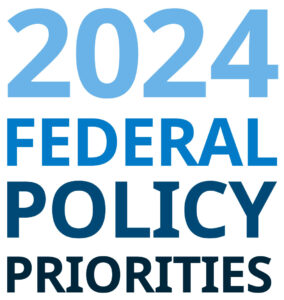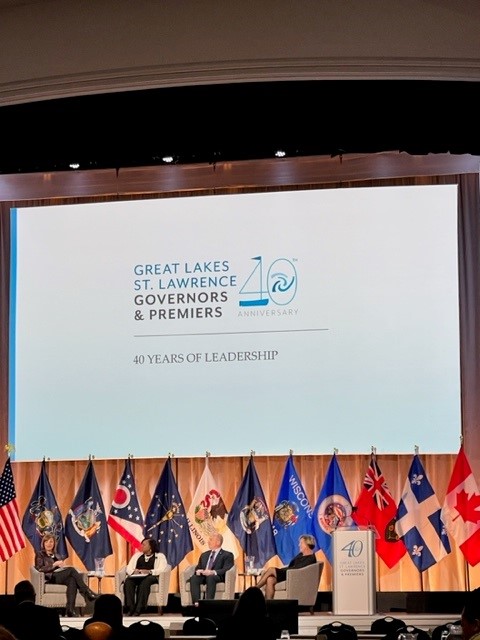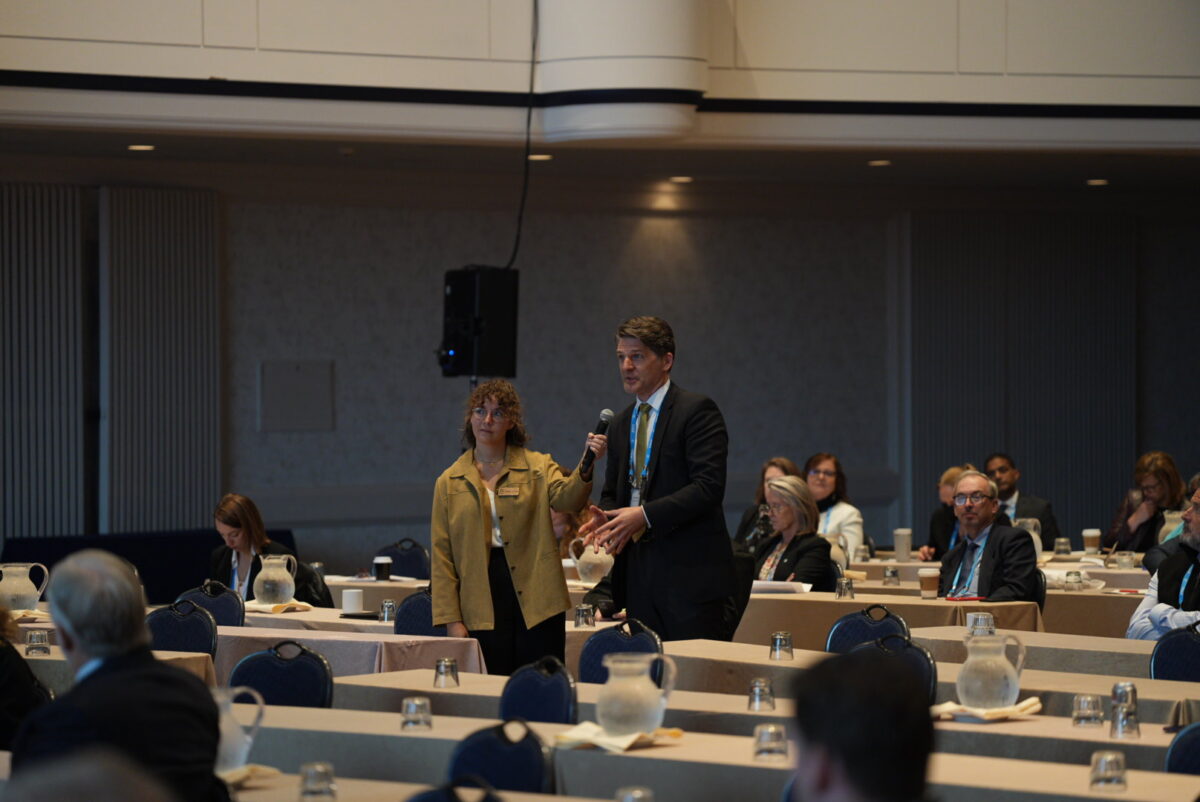Top 5 Great Lakes Federal Policy Priorities for 2024

Significant progress continues to be made in protecting and restoring the Great Lakes, but much more needs to be done. Although increased federal funding from the Infrastructure Investment Act these last two years has allowed states and the federal government to address some key issues, including water infrastructure and the cleanup of toxic legacy pollution, we still have too many Great Lakers experiencing polluted water. Invasive species continue to threaten the lakes, nutrient runoff continues to negatively affect our water quality, and plastic pollutes our beaches and drinking water.
In our 2024 federal policy priorities, we’ve identified the top five opportunities for Congress and federal agencies to address these challenges. Many of these priorities are familiar and are carried over from last year when Congress made little progress on substantive legislation. For the upcoming year, Congress and the administration must address key issues. These include passing an annual federal budget to provide states with sufficient federal resources to fix our ailing water infrastructure; enacting a Farm Bill that will reduce the flow of nutrient pollution into the lakes; maintaining progress on key federal projects intended to stop invasive species; and providing funding and reauthorization for the Great Lakes Restoration Initiative to continue support for on-the-ground restoration projects.
Equity and justice are embedded throughout these policy priorities and must be considered at every step of the federal decision-making process to ensure that all Great Lakers have access to safe, clean, affordable water. Repairing the long-term harm from environmental injustices isn’t a one-off action and federal decision-makers must prioritize disadvantaged communities where the burden of pollution and the lack of essential services often hit the hardest. Congress and the administration must ensure that community voices are at the table – and listened to – from the beginning of all decision-making.
Read on for full details of our 2024 Great Lakes federal policy priorities, or download the fact sheet to learn more.

Increase water infrastructure funding, prioritize funding for communities most in need
The Infrastructure Investment and Jobs Act passed by Congress late in 2021 was an important down payment to fix the nation’s failing and outdated water infrastructure. The funding will jump-start efforts to replace dangerous lead pipes, fix leaky pipes, and stop sewage overflows.
However, the funding is only a start. EPA’s 7th national Drinking Water Needs Information Survey and Assessment, completed just last year, estimates that the Great Lakes region will need at least $225.2 billion over the next twenty years to fix our water infrastructure problems. This is an increase from the last national survey and indicates that federal funding is not keeping up with needs. Currently, the infrastructure bill will provide Great Lakes states with an additional $1.8 billion per year for the next five years. It is clearly not enough. We need to keep the pressure on Congress to provide additional funds for water infrastructure programs. Additionally, funding programs must be structured to ensure that money reaches communities with the highest need, such as those with many lead pipes.
In 2024, we urge Congress to:
- Increase annual funding to at least $9.3 billion for the Drinking Water and Clean Water State Revolving Funds
- Increase by $1 billion annual funding levels for lead service line replacement and emerging contaminants
- Set aside at least 20 percent of the Clean Water State Revolving Fund as grants for green infrastructure projects such as green roofs, permeable pavement, and additional green spaces
- Pass a federal ban on residential water shutoffs
- Establish a federal program to provide financial assistance for water and sewer bills
In 2024 we urge the U.S. Environmental Protection Agency to:
- Require that states accepting federal funds from the Infrastructure Investment and Jobs Act of 2021 are increasing funding and technical assistance for disadvantaged communities so that they are equipped to advance through the SRF selection process
- Issue a final Lead and Copper Rule requiring cities to meet ambitious timelines for lead service line replacement
Download the water infrastructure fact sheet.

Pass a Farm Bill that prioritizes clean water
Agriculture is the largest unaddressed source of nonpoint pollution in the Great Lakes region. Runoff from agricultural lands puts the Great Lakes at risk. It pollutes drinking water, threatens wildlife, harms the regional economy, and prevents people from enjoying recreation on the Great Lakes.
Every five years, Congress develops a “Farm Bill,” a major package of legislation that sets the agenda and funding for national farm and food policy. Congress passed a one-year extension of the Farm Bill in 2023, so in 2024 Congress can pass a Farm Bill that ensures farms produce clean water, not pollution, along with their crops.
In 2024, we urge Congress to pass a Farm Bill that:
- Increases funding for U.S. Department of Agriculture conservation programs
- Includes provisions to ensure accountability for farm conservation programs aimed at stopping runoff pollution from agricultural lands
- Reduces funding for concentrated animal feeding operations
Download the agriculture fact sheet.

Pass legislation to stop plastic pollution
Researchers estimate that 22 million pounds of plastic pollution enter the Great Lakes each year. Plastic pollution isn’t just an unsightly problem in our waterways. It’s estimated that humans ingest a credit card-sized amount of plastic each week, with unknown long-term consequences for our health.
For many years, efforts to stop plastic pollution put the responsibility on the end-user, such as recycling. But only a fraction of plastic produced each year is recycled, leaving the remainder to end up in landfills or as litter that lands in our waterways. The alternative is to require plastic producers to be responsible for their products through their lifecycle, which is called extended producer responsibility. Congress has an opportunity to be a leader on this issue.
In 2024, we urge Congress to pass legislation that:
- Makes plastic waste producers responsible for its reduction
- Reduces the federal government’s use of single-use plastics, including polystyrene foam
- Funds additional research on the public health impact of plastics
Download the plastic pollution fact sheet.

Protect the Great Lakes from aquatic invasive species
Invasive species have caused irreparable harm to the Great Lakes ecosystem and cost the region billions of dollars since the late 1980s. Preventing them from ever entering is the best way to protect the Great Lakes. The battle against invasive species is focused on two fronts – stopping invasive carp from entering the Great Lakes and cleaning up ship ballast tanks.
Established populations of invasive carp are only 50 miles from Chicago and Lake Michigan. But it’s not too late to prevent them from reaching the lakes. The U.S. Army Corps of Engineers has proposed constructing additional carp prevention measures at the Brandon Road Lock and Dam near Joliet, Illinois. The facility is a critical choke point in the waterways leading to Lake Michigan. Congress and federal agencies must continue to support this project.
The St. Lawrence Seaway opened the Great Lakes to direct ocean-going shipping. Unfortunately, ships brought invasive species along for the ride in their ballast tanks. Although regulations to clean up ship ballast tanks have reduced introductions, loopholes remain for “lakers,” ships operating solely in the Great Lakes. The U.S. EPA can close that loophole.
In 2024, we urge Congress to:
- Include language in the next Water Resources Development Act to authorize 100 percent federal funding for the annual operations and maintenance of the Brandon Road Interbasin Project, which is being implemented to stop invasive carp from entering the Great Lakes
In 2024, we urge federal agencies to take the following actions:
- The U.S. Army Corps of Engineers should execute a Project Partnership Agreement with the State of Illinois for the Brandon Road Interbasin Project so that the project may proceed to phase 1 construction this fall and continue public participation for the project’s implementation
- The U.S. EPA should issue final rules requiring all vessels operating on the Great Lakes, including lakers, to clean up their ballast tanks
Download the invasive species fact sheet.

Fund, update, and reauthorize the Great Lakes Restoration Initiative
The Great Lakes Restoration Initiative (GLRI) is one of the most important tools in the region’s toolbox to protect and restore the lakes. The program provides funding for on-the-ground restoration projects, from wetland restoration to cleaning up toxic hotspots. In addition to environmental benefits, GLRI funding garners an additional 3-to-1 return in economic benefits.
While we need continued investment in Great Lakes restoration, the strategy guiding the GLRI was developed almost 20 years ago and needs an update. Federal agencies should revise the Great Lakes restoration strategy to address the next generation of threats to the lakes, including climate change and long-standing environmental injustices. In addition, the program’s authorization will expire in 2026, so action will be needed by Congress in the near future to reauthorize and extend the GLRI program.
In 2024, we urge Congress to:
- Fund the GLRI with at least $450 million in FY 2024
- Reauthorize the GLRI program at $500 million per year for five years from FY 2027-2031
In 2024, we urge the U.S. Environmental Protection Agency to take the following action:
- U.S. EPA should issue the Great Lakes Restoration Initiative Action Plan IV to address environmental injustice, climate resilience, and the next generation of risks to the Great Lakes
Download the Great Lakes restoration fact sheet.
The post Top 5 Great Lakes Federal Policy Priorities for 2024 appeared first on Alliance for the Great Lakes.
News - Alliance for the Great Lakes
News - Alliance for the Great Lakes
https://greatlakes.org/2024/02/top-5-great-lakes-federal-policy-priorities-for-2024/








